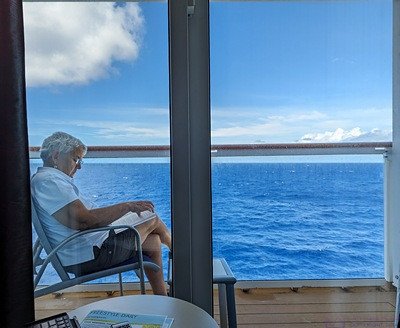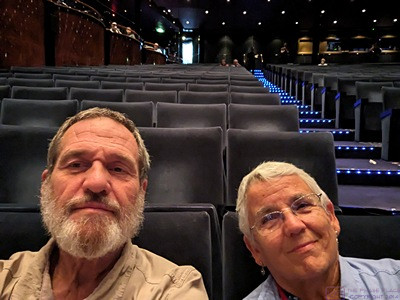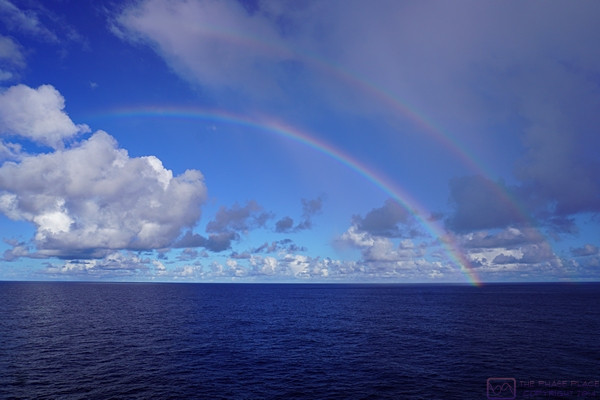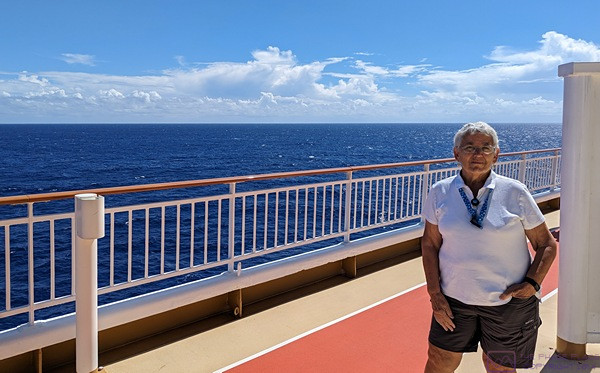Note: This is the 11th of 16 posts about our 21-day trip that included a 17-day (16-night) cruise on the Norwegian Cruise Line (NCL) ship SPIRIT from Vancouver, British Columbia to Honolulu, Oahu. This post has six (6) photographs with captions and some narrative. Photos were taken by me (Bruce) using a SONY alpha 6400 or Google Pixel 6 Pro unless otherwise noted. (Photos by Linda were taken with a Google Pixel 6.)
WEDNESDAY 06 – SUNDAY 10 September 2023 — (T11-15,C8-12) At Sea on the North Pacific Ocean, and a Death at Sea (not one us)
The NCL SPIRIT departed Sitka, Alaska late yesterday afternoon and headed out into the open ocean for what would be our first of five (5) nights crossing the North Pacific Ocean to Kauai, Hawaii. Once out of sight of land, we would be at sea for all or part of six (6) days, and not see land it again until the morning of Monday, 11 September, when we were scheduled to arrive in the port at Nawiliwili, Kauai, Hawaii.
Our main reason for doing this cruise was to see southeast coastal Alaska for the first time and make a return visit to the Hawaiian Islands, but this time on a cruise ship. Another reason for doing this cruise was that we had originally booked the same cruise on the same ship for June 2025, but with the itinerary starting in Hawaii and ending in Vancouver, British Columbia, Canada. That cruise was canceled by NCL, but Linda found this one in time to book a balcony stateroom in an acceptable location on the ship.
Another reason for doing this cruise at this time, as opposed to some unspecified future date, was to see how we would do spending extended days at sea. Early in 2023 Linda (and Nancy) had booked a 4-month world cruise, starting in early January 2025, on the MSC Magnifica and we wanted to determine if we would be okay with extended sea days while we still had time to cancel that booking and get a full refund of our deposit.
I can report that we were fine being on the open ocean, out of sight of land and even other marine traffic, for an extended time. We were favored with good weather, which probably helped, but we have been on cruise ships in less-than-ideal conditions, so we already knew we could handle that, at least for 48 hours. While ports-of-call are usually new places to visit, with lots of opportunities for new, interesting, and even exciting experiences, cruise ships are fundamentally floating cities, with all of the necessities of life, i.e., housekeeping, interior climate control, food–water–sanitation, and lots of activities and amenities such as: entertainment, games, lectures, libraries, music venues, exercise rooms and classes, casinos and, of course, bars and lounges. (I borrowed a book on the Bauhaus and managed to read it during the cruise.) And shopping (lots of shopping). Most ships have a walking track or promenade, so we could stroll there as an alternative to walking the shop and restaurant decks. And we had our stateroom where we could relax, read, work puzzles, or just rest. Without the hustle and bustle of going ashore and being part of shore excursions, we found our days at sea quite relaxing. When the weather was amenable, we could sit on our private balcony, or go enjoy coffee in a more public, but still relaxing area of the ship. Indeed, for many people, us included, the ship itself is an enjoyable experience.
What we did not do is “document” our time at sea, in part because the only things that change about the ocean are the weather and waves. Sunrise and sunset are especially nice times, of course, and we hoped to see amazing stars at night. But we knew from our Panama Canal cruise that the sky might be obscured by clouds, and the outside lighting on cruise ships never really turns off (presumably for visibility and safety) so the “dark sky” experience is elusive to non-existent. It was also difficult to get photos that did not include other guests, especially their faces. But at its core, while photography is a pleasurable hobby, it can be a bit of work, we just wanted to relax.
Following are a few photos to give you a sense of our time at sea on the North Pacific Ocean.

On our third full day at sea, Linda relaxes on our balcony with a book as the ship glides along under fair weather. These large cruise ships are very stable and move smoothly through the water, all while traveling at 20 – 22 knots.

A selfie sitting in the main theater waiting for the second show of the evening’s entertainment. We got there early to get good seats, thus the empty seats behind us.

A panoramic composite of 8 images showing storm clouds brewing on the horizon at sunset. I “enhanced” this photo in post-processing to bring out some of the colors (artistic license) but hopefully have not overdone it.

In spite of relatively good weather, we did have occasional rainclouds. As shown here, we were treated to a double rainbow one day. (Again, I have also used my artistic license to “enhance” this photo in post-processing to bring out the rainbows. Again, hopefully have not overdone it.

This is the book I checked out of the ship’s library. Though small, the library had a (perhaps surprisingly) good collection of “serious” books like this one, especially on travel and art. People using the library as a game room were quiet and respectful of others who might be reading. It was a small, but wonderful alternative place to the larger public spaces to spend some time without feeling cooped up in our stateroom. (Note: There is no reason to feel cooped up in a cruise ship cabin. The ship is a floating city that operates 24 hours a day with massive amounts of deck square footage.)
…
Epilogue — A Death at Sea
The most unexpected thing that happened during our entire trip/cruise was that the women in one of the cabins next to ours passed away while the ship was crossing the North Pacific Ocean. We were only aware of this because we heard conversation in the hallway one morning around sunrise and opened the door to see what was going on. The husband was talking to some crew members, and told us that she had taken ill in their cabin a day earlier and was moved to the medical center but died during the night.
Yes, cruise ships have medical centers. I think the one on the NCL SPIRIT is typical of cruise ships of this class; a small medical center with two doctors and a nurse/technician, lab equipment including an X-Ray machine, and a small pharmacy. Apparently this woman already had breathing and other health issues (asthma or COPD, but I don’t recall exactly) and was quickly diagnosed with CoVID-19 as well. We chatted with the husband (listened, mostly) during the next couple of days. He was very impressed with the care and skill of the entire crew, especially the medical staff as they worked to treat her, but she lapsed into a comma and passed away before the ship could reach Nawiliwili, Kauai, Hawaii and we were too far from land for an aero medivac. The command staff gave him access to a phone so he could call relatives with the sad news and call someone in Nawiliwili, Kauai, Hawaii to make arrangements for the transfer of her body to shore and transportation home (lower 48 states in the USA).
It turns out that cruise ships also have a mortuary because, as it turns out, deaths do occur at sea on cruise ships. Not many, but it does happen. I decided to do some light research (web search) on the subject and found the following from TouristSecrets.com:
“The Cruise Lines International Association (CLIA) reports that the mortality rate on cruises is considerably lower than on land-based vacations or other modes of transportation. It is estimated that the annual mortality rate on cruise ships ranges between 0.14 and 0.25 deaths per 100,000 passengers.” That’s 1.4 to 2.5 deaths per 1,000,000 passenger bookings, or roughly “1 in a million.” This can also be expressed as 0.000014 to 0.000025 deaths per 100 passengers, which is 0.0014% to 0.0025%. Any way you look at it, these are very low numbers or probabilities. So, on a cruise ship with 3,000 guests and 1,500 crew (4,500 total people) the percentage chance of someone dying is 0.0063% to 0.0113% (to 4 decimal places). But these are not random (roll of the dice) probabilities because people don’t just die on cruise ships for no reason anymore than they do on land.
Here is what I found (courtesy of Bing AI):
On average, approximately 200 people meet their fate aboard cruise ships each year (out of multiple millions of passenger bookings). While the majority of these deaths result from natural causes, there are instances of accidents, suicides, and even murders. Here are some key points about cruise ship deaths:
- Natural Causes: Most onboard deaths occur due to natural causes. These include health-related issues, age-related factors, and pre-existing conditions. However, not all cruise lines and countries consistently share their death statistics, so the actual number may be higher than reported.
- Accidents: Accidental deaths can happen on cruise ships. These may involve slips, falls, or other unforeseen incidents. Accidents can occur both at sea and while the ship is docked. (Cruise ships are constantly moving when underway, and even when docked, and movement can be significant in really bad weather. These ships also have a LOT of stairs, although elevators provide access to all guest floors. Anyone with balance/stability/walking issues should be mindful of these factors.)
- Murders: While incredibly rare, cruise ship murders do occur. These are usually committed by someone the victim knows, often during heated arguments or due to a history of abuse. Guns are strictly prohibited on cruise ships, so most murders involve stabbings or pushing victims overboard.
I would add suicide to the list. Again, very rare, but they do occur. Remember that these incidents represent an incredibly small fraction of the millions of passenger bookings each year. The overall risk remains (extremely) low, but serve as a reminder that it’s essential to be aware of health and and safety measures/protocols while at sea. And there is some comfort, I suppose, in knowing that cruise ships are prepared to deal with these situations.
…
